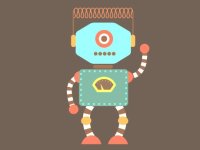Learning With Robots: Content Mastery and Social Skills
When introducing younger students to robots, the high-engagement nature of these tools can add a social-emotional layer to the more obvious learning goals.
Your content has been saved!
Go to My Saved Content.You live in the age of robots. A robot built your car, opened your garage door, and made the espresso that went into your double mocha. In large and small ways, robots are everywhere in our lives.
The robots in my classroom amplify learning for my students. Robots are another tool in my high-engagement toolbox. I use the term high-engagement as a description and a warning. In my experience, high-engagement tools need to be matched with high-challenge learning. If we are using robots to support learning goals, the learning goals have to be robust and demanding. Without a carefully crafted learning context to support a demanding learning goal, students end up engaging the learning medium and just playing with robots.
High Engagement, Sharing, and Reflection
I start in kindergarten with Bee-Bots. They are really simple robots -- rechargeable, self-contained, and only minimally programmable. My computer science goal is to get the students comfortable with the technology, and to have them understand the relationship between the commands they input and the actions the robot takes once they press the GO button.
So how do I layer learning goals into a lesson that will keep the kids actively learning through the robots and not just playing with the robots? Beyond the simplest mechanics of programming, I focus on social skills. Sharing, turn taking, and communication are major goals for our kindergarten students. Can I get four students to work together on one robot and structure this learning in such a way that the students are building their social skills at the same time as they build their understanding of computer science and robotics?
I start planning by following the best advice available for group work -- I borrow the concept of roles within the group from literature circles. Of course, there is a great deal of adapting to do, and I think there is still some work for improvement.
When I am using the Bee-Bots in grades K and 1, the roles might look like this:
- The Head Programmer plans the next move.
- The Code Writer puts the command cards in order.
- The Command Keyer keys in the commands.
- The Debugger tracks where in the program the robot currently is and fixes any problems that arise.
As the students work, the adults in the room observe and call out great examples when we see them. Two or three times in the course of the lesson, I will stop all the robots and ask group members to share something they learned or noticed. These reflective breaks are great because they give the students a chance to formalize their understanding and share it with each other, creating space for metacognition and breaking up the momentum of the activity.
Learning Goals and Skill Levels
This group structure works well with the Bee-Bots because those robots are designed to navigate on a mat. The mat is big enough for four kids to sit around with equal access. My other robot of choice, the Sphero, is controlled by an app on a mobile tablet. With the Sphero, I usually have the students working in pairs. This robot's app-based control makes it challenging to actively engage more that two students at a time, but the price point on the Spheros is lower than the Bee-Bots, so while I might need more robots to engage my students in a full-class lesson, the opportunity cost is comparable.
When I am thinking about differentiation in the lesson, I don't base it on the tech skills, but on elements such as social skills or content area knowledge. For my kindergarten class, the teachers group the kids in mixed social skill groups, so that each group has a variety of social skill levels. When we pair students up to work on the Spheros, we will often group them in like skill levels. I have to note here that when you have two students who do not enjoy sharing and ask them to share an iPad and a robot, you should be ready to support those students with frequent intervention. (It's also great idea to have the iPad in a heavy-duty case that can tolerate being dropped, as well as a robot that is as tough as the Sphero.)
In addition to social learning, we connect to content with robots. We want to make sure that we have the robots moving for a reason. My first grade students have to program a robot to fly from one planet in the solar system to the next. Second graders construct two-dimensional geometric shapes by programming Spheros to draw a square, a triangle, a pentagon, and maybe even a dodecahedron. (Always prepare more challenges than you think they can meet.) As we introduce more complex programming platforms, our learning goals also become more complex -- consider the possibilities of discovering rate x time = distance instead of just practicing it.
Do you use robots to support social and content goals in your class? What could you teach through robots? Share your idea in the comments, and let's think carefully together about the best ways to teach through robots.
